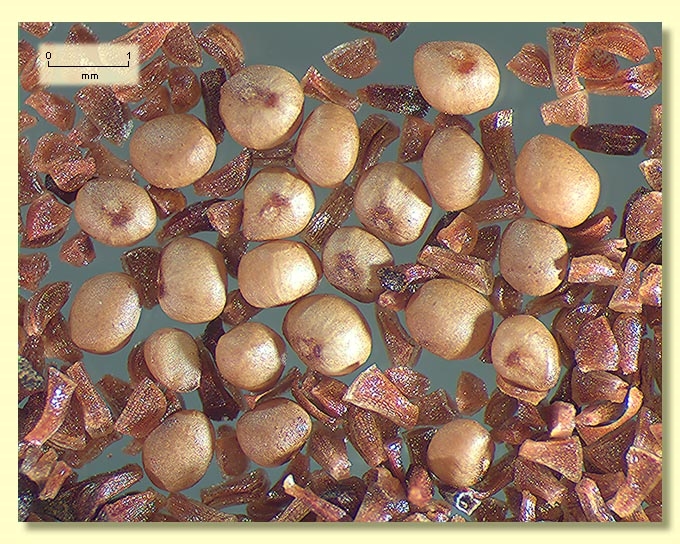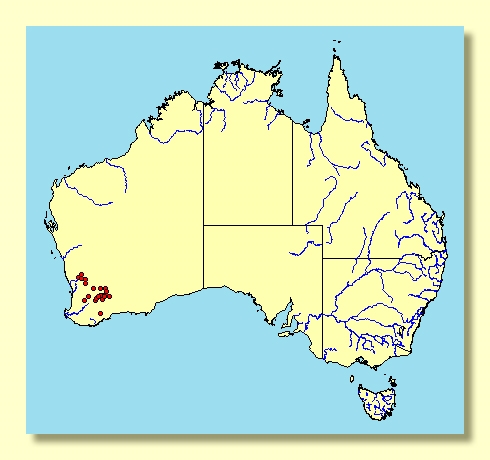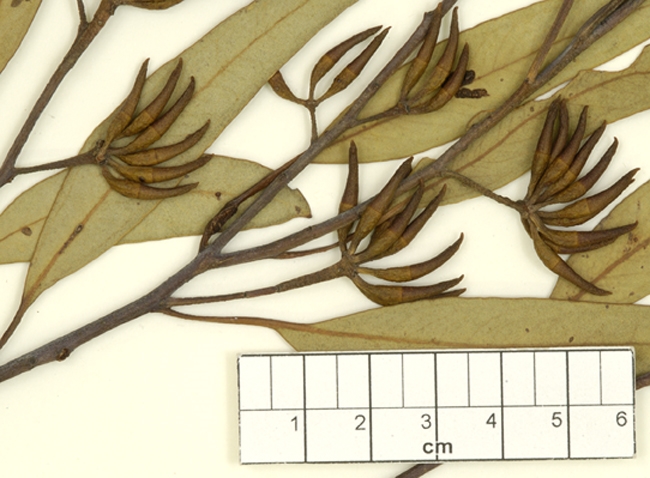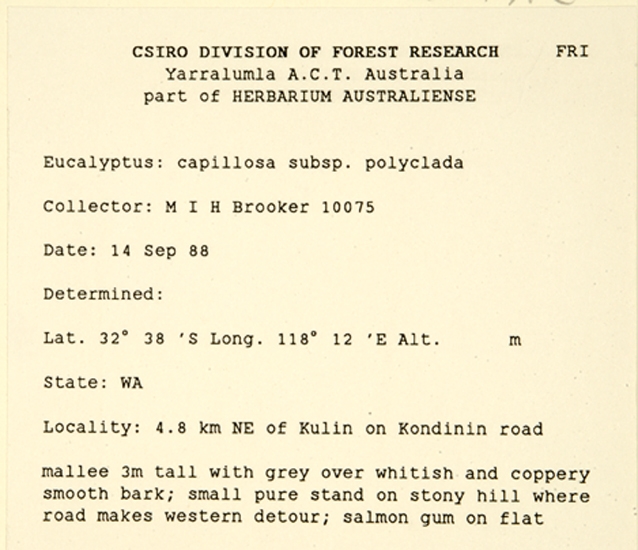Euclid - Online edition
Eucalyptus capillosa subsp. polyclada
Classification
Eucalyptus | Symphyomyrtus | Bisectae | Glandulosae | Levispermae | Cubiformes
Nomenclature
Description
Mallee to 12 m tall. Forming a lignotuber.
Bark smooth throughout, dark and pale grey over salmon pink or pale orange.
Branchlets usually glaucous, oil glands present in pith.
Juvenile growth (coppice or field seedlings to 50 cm): stems rounded in cross-section, glaucous, scabrid for at least lower part; juvenile leaves always petiolate, opposite for about ca 4 nodes then alternate, 5–7 cm long, 2–3.5 cm wide, margin appearing irregular due to hairs on lowest leaves at least, glaucous; stems, petioles and both leaf surfaces scabrid for at least 8 pairs of leaves then glabrous.
Adult leaves alternate, petioles 1–2.5 cm long; blade lanceolate to elliptical, 7–12.5 cm long, 1–2.2 cm wide, base tapering to petiole, margin entire, apex pointed, concolorous, dull, grey-green or blue-green to green, side-veins at an acute or wider angle to midrib, reticulation moderate to dense, intramarginal vein remote from margin, oil glands mostly intersectional.
Inflorescence axillary unbranched, peduncles 0.6–1.8 cm long, widening apically, buds 9 to 13 per umbel, rarely more than 15, pedicels 0.2–0.5 cm long. Mature buds fusiform (0.8–1.6 cm long, 0.2–0.4 cm wide), scar present, operculum conical, to twice as long as hypanthium and equal to it at the join, few outer stamens erect, most stamens variably deflexed, anthers oblong, versatile, dorsifixed, dehiscing by longitudinal slits, style long and straight, stigma blunt or tapered, locules 3, the placentae each with 4 vertical rows of ovules. Flowers white.
Fruit pedicellate (pedicels 0.2–0.3 cm long), barrel-shaped to obconical, 0.6–0.8 cm long, 0.4–0.6 cm wide, disc descending, valves 3, near rim level or rarely enclosed.
Seeds pale brown to straw-coloured, 0.8–1.5 mm long, sub-spherical, surface smooth, hilum ventral/terminal.
Cultivated seedlings (measured at ca node 10): cotyledons Y-shaped (bisected); stems rounded in cross-section, glaucous, densely warty-scabrid (the warts have terminal hairs); leaves always petiolate, opposite for 4 to 8 nodes then alternate, ovate-lanceolate, 3.5–8.5 cm long, 1.2–3.5 cm wide, margin slightly to quite irregular or undulate, lamina and petiole conspicuously warty-hairy, glaucous. The hairs have a multicellular base surmounted by a pair of long cells that are basally appressed, and apically divergent.
Bark smooth throughout, dark and pale grey over salmon pink or pale orange.
Branchlets usually glaucous, oil glands present in pith.
Juvenile growth (coppice or field seedlings to 50 cm): stems rounded in cross-section, glaucous, scabrid for at least lower part; juvenile leaves always petiolate, opposite for about ca 4 nodes then alternate, 5–7 cm long, 2–3.5 cm wide, margin appearing irregular due to hairs on lowest leaves at least, glaucous; stems, petioles and both leaf surfaces scabrid for at least 8 pairs of leaves then glabrous.
Adult leaves alternate, petioles 1–2.5 cm long; blade lanceolate to elliptical, 7–12.5 cm long, 1–2.2 cm wide, base tapering to petiole, margin entire, apex pointed, concolorous, dull, grey-green or blue-green to green, side-veins at an acute or wider angle to midrib, reticulation moderate to dense, intramarginal vein remote from margin, oil glands mostly intersectional.
Inflorescence axillary unbranched, peduncles 0.6–1.8 cm long, widening apically, buds 9 to 13 per umbel, rarely more than 15, pedicels 0.2–0.5 cm long. Mature buds fusiform (0.8–1.6 cm long, 0.2–0.4 cm wide), scar present, operculum conical, to twice as long as hypanthium and equal to it at the join, few outer stamens erect, most stamens variably deflexed, anthers oblong, versatile, dorsifixed, dehiscing by longitudinal slits, style long and straight, stigma blunt or tapered, locules 3, the placentae each with 4 vertical rows of ovules. Flowers white.
Fruit pedicellate (pedicels 0.2–0.3 cm long), barrel-shaped to obconical, 0.6–0.8 cm long, 0.4–0.6 cm wide, disc descending, valves 3, near rim level or rarely enclosed.
Seeds pale brown to straw-coloured, 0.8–1.5 mm long, sub-spherical, surface smooth, hilum ventral/terminal.
Cultivated seedlings (measured at ca node 10): cotyledons Y-shaped (bisected); stems rounded in cross-section, glaucous, densely warty-scabrid (the warts have terminal hairs); leaves always petiolate, opposite for 4 to 8 nodes then alternate, ovate-lanceolate, 3.5–8.5 cm long, 1.2–3.5 cm wide, margin slightly to quite irregular or undulate, lamina and petiole conspicuously warty-hairy, glaucous. The hairs have a multicellular base surmounted by a pair of long cells that are basally appressed, and apically divergent.
Flowering Time
Flowering has been recorded in February, June and December.
Notes
Eucalyptus capillosa is a tree or mallee species endemic to Western Australia, found in the central and eastern wheatbelt. The bark is smooth, the adult leaves dull and the juvenile leaves are hairy-scabrid.
It belongs to Eucalyptus subgenus Symphyomyrtus section Bisectae subsection Glandulosae because the cotyledons are bisected, buds have an operculum scar and the branchlets have oil glands in the pith. Within this subsection E. capillosa is one of a group of 14 species that form series Levispermae subseries Cubiformes, characterised by having smooth almost cuboid to sub-spherical seed (not spherical), flattened peduncles that widen apically and buds that are narrowly fusiform with some stamens erect and others variably deflexed.
E. capillosa differs from all related species in series Levispermae, except E. nigrifunda and E. livida, by having scabrid seedling and juvenile leaves. It has a more inland distribution than the common and closely related tree E. wandoo. E. nigrifunda differs from E. capillosa only in having some rough blackish bark on the trunk and a more arid distribution on lateritic breakaways and associated flats in the Great Victoria Desert. E. capillosa differs from E. livida in always having glaucous branchlets. E. livida is non-glaucous and has a much greyer crown than E. capillosa and is restricted to rocky sites.
There are two subspecies:
E. capillosa subsp. capillosa
A tree more widely distributed than subsp. polyclada, forming woodlands on heavier soils but often on lateritic rises in its eastern occurrence. Occurs east from Pithara, Kellerberrin and Brookton to the Die Hardy Range and Southern Cross.
E. capillosa subsp. polyclada
A mallee of the central wheatbelt from Pithara north-east of Perth south-east to Wickepin and Burngup and east to the "Hyden Scrub", on sandy and gravelly sites, not associated with breakaways. Dubiously distinct from the typical subspecies, its mallee habit may reflect simply harsher growing conditions.
It belongs to Eucalyptus subgenus Symphyomyrtus section Bisectae subsection Glandulosae because the cotyledons are bisected, buds have an operculum scar and the branchlets have oil glands in the pith. Within this subsection E. capillosa is one of a group of 14 species that form series Levispermae subseries Cubiformes, characterised by having smooth almost cuboid to sub-spherical seed (not spherical), flattened peduncles that widen apically and buds that are narrowly fusiform with some stamens erect and others variably deflexed.
E. capillosa differs from all related species in series Levispermae, except E. nigrifunda and E. livida, by having scabrid seedling and juvenile leaves. It has a more inland distribution than the common and closely related tree E. wandoo. E. nigrifunda differs from E. capillosa only in having some rough blackish bark on the trunk and a more arid distribution on lateritic breakaways and associated flats in the Great Victoria Desert. E. capillosa differs from E. livida in always having glaucous branchlets. E. livida is non-glaucous and has a much greyer crown than E. capillosa and is restricted to rocky sites.
There are two subspecies:
E. capillosa subsp. capillosa
A tree more widely distributed than subsp. polyclada, forming woodlands on heavier soils but often on lateritic rises in its eastern occurrence. Occurs east from Pithara, Kellerberrin and Brookton to the Die Hardy Range and Southern Cross.
E. capillosa subsp. polyclada
A mallee of the central wheatbelt from Pithara north-east of Perth south-east to Wickepin and Burngup and east to the "Hyden Scrub", on sandy and gravelly sites, not associated with breakaways. Dubiously distinct from the typical subspecies, its mallee habit may reflect simply harsher growing conditions.
Origin of Name
Eucalyptus capillosa: Latin capillosus, hairy, referring to the seedlings.
subsp. polyclada: Greek poly-, many and clados, branch, referring to the mallee form.
subsp. polyclada: Greek poly-, many and clados, branch, referring to the mallee form.
Copyright © CANBR 2020, all rights reserved.

Web edition hosted at https://apps.lucidcentral.org/euclid















